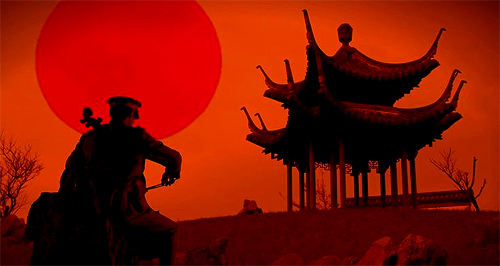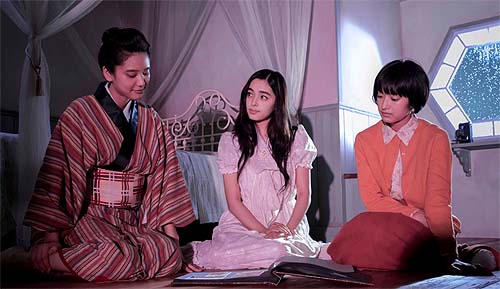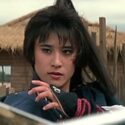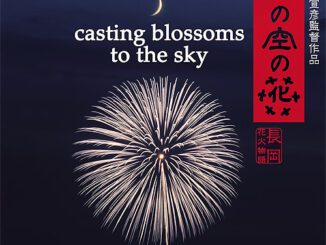Flower Basket, Hanagatami (2017)
Directed by: Nobuhiko Ôbayashi
Written by: Chiho Katsura, Kazuo Dan, Nobuhiko Obayashi
Starring: Honoka Miki, Shunsuke Kubozuka, Takako Tokiwa, Tokio Emoto
Part of the Nobuhiko Obayashi Anti-War Trilogy
Available now from Third Window Films
The final part of this trilogy comes in the form of a period drama several decades in the making. Facing a terminal illness the director set out to finish an idea that could become his final film. He would in fact make one more feature, Labyrinth of Cinema, a few years later. Still, this being one last passion project is a tantalising prospect. The same sentiments explored in Obayashi’s previous two releases are present as young people are faced with a destructive conflict. However, while there are many similar visual flourishes there’s a sense that much of the characterisation and the themes of the story as a whole are lacking.

The year is 1941, during what will be the lead up to the Japanese attack on Pearl Harbour and the war against the United States. Several characters already have lost loved ones in Manchuria, and these ghosts hang over the proceedings. Unfortunately what exactly is going on overseas is never explained in any detail. The tragedy of lost sons and husbands may speak for itself in some ways, but there’s a frustrating lack of context throughout the story that hinders this message. This lack of understanding may be intentional when the cast consists mostly of high school students, some who will never see the frontlines, but the result is often more soap opera than social message.
Toshihiko (Shunsuke Kubozuka) is an annoyingly childish lead character, arriving at a rural school from Holland to stay with his Aunt Keiko (Takako Tokiwa). Her husband passed away after joining the military despite having a serious illness, and Toshihiko’s cousin Mina (Honoka Yahagi) seems to be dying from a similar tuberculosis condition. There are suggestions that they will have to marry so that Toshihiko can be given property on the family estate, but it seems obvious this will never come to pass. However, rather than this being a compelling study of illness, at a time when the director was facing his last years, it becomes a tale of love triangles and teenage melodrama.
Obayashi’s usual editing choices also prevent this from being too engaging. There are more wonky green screens, random left-to-right camera flips during dialogue, and colours that change from naturalistic to artificial. The material is pretty dark and yet it feels like it could be a comedy at times. It doesn’t help that most of the students look like they are in their thirties. Kira (Keishi Nagatsuka) is both physically and mentally ill, dealing with a childhood disability and other issues that are revealed later on. His treatment of a pet dog is a sign of things to come and it’s a mystery why Toshihiko wants to get to know him. Ukai (Shinnosuke Mitsushima) on the other hand seems to be a more heroic figure but has issues of his own.

These central characters mean that it’s not entirely without intrigue, though much of it is as disjointed as it is disturbing. Their teacher joins the war (Takehiro Murata also looking older than a drafted soldier) while they take photos and dance at picnics. Toshihiko is more concerned with whether it’s cool to smoke cigarettes rather than showing signs of self awareness. Many of his classmates (and his Aunt and cousin) have a kind of melancholy owing to personal loss, and yet spending time at bars and festivals is often given priority. Perhaps they’re simply avoiding the reality of being doomed in their own individual ways, or perhaps the script is just too unfocused.
There’s a sense that the students are all drowning and just don’t know it yet, and that tests of manhood like drinking, jumping from cliffs, and even riding horses in the nude are distractions from the inevitable. Kira’s own cousin Chitose (Mugi Kadowaki) also shares a stomach churning secret as the story spirals from social events to sexual exploration and self destruction. This is all in sharp contrast to the frivolous nature of tea parties and posing in luxurious outfits, so again perhaps that’s part of the overall message. Then again it would be nice to see the film explore more of the historical situation; beyond a general idea that so much loss of life to battle, and to sickness, is bad.
The results are unfortunately the least interesting part of this loosely connected trilogy, rather than the culmination of a series of ideas. Partly sentimental and partly horrifying it paints another broad picture of nostalgic times marred by death, a time that Toshihiko eventually realises has slipped away. But it’s also the one film in the series that feels like it doesn’t need to be almost three hours long. Joining a senseless military campaign might be as productive as throwing yourself into the ocean, but it’s an idea that could be delivered with far more brevity. World cinema completists and fans of the director will want to see this but overall it’s far from essential, particularly after Seven Weeks.





Be the first to comment